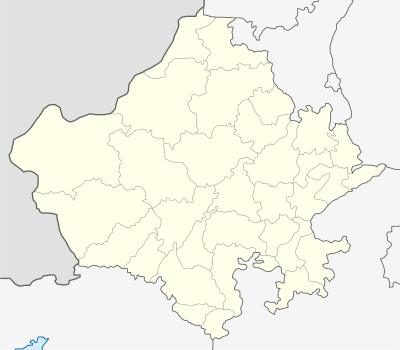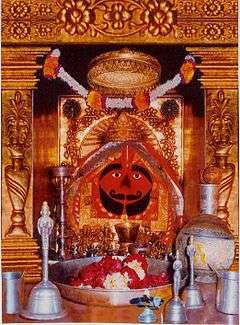Salasar Balaji
| Salasar Balaji | |
|---|---|
|
Idol of Balaji in Salasar Balaji temple | |
 Salasar Balaji Location of Salasar Balaji temple in Rajasthan | |
| Geography | |
| Coordinates | 27°43′N 74°43′E / 27.72°N 74.71°ECoordinates: 27°43′N 74°43′E / 27.72°N 74.71°E |
| Country | India |
| State/province | Rajasthan |
| District | Churu |
| Locale | Salasar Balaji |
| Culture | |
| Primary deity | Hanuman |
| History and governance | |
| Date built | 9th day the bright half of Shraavana in the samvat 1811 (1754 AD) |
| Creator | Mohandas Maharaj |
Salasar Balaji or Salasar Dham in India is a place of religious importance for the devotees of Hanuman. It is located in the town of Salasar, on National Highway 65 near Sujangarh in Churu district, Rajasthan. The temple of Balaji, another name of Hanuman, is situated in the middle of Salasar and attracts innumerable worshippers throughout the year. On Chaitra Purnima and Ashvin Purnima, large fairs are organised that attract devotees as they pay homage to the deity.
Salasar Balaji is in the religious circuit that includes the pilgrim centres of Rani Sati Temple and Khatushyamji, which are both located close to it. Initially a small construction, the temple of Salasar Balaji is now considered to be a Shakti Sthal (a place of power) and Swayambhu (self creation) by faith, belief, miracles and wish fulfilments of the devotees.
Legend
There are several theories concerning the origins of Salasar Balaji.
One claims the discovery of the site by Ginthala Jat of Asota village in Nagaur district of Rajasthan. On one Saturday of Shraavana shukla Navami samvat 1811 (1754 AD), a miracle happened. A Ginthala Jat farmer of Asota village was ploughing his field when all of sudden the plough was hit by a stony thing and a resonating sound was created. He dug up the soil of that place and found an idol covered with sand. His wife reached there with his lunch. The farmer showed the idol to his wife. She cleaned up the idol with her saree. The idol was that of Balaji (Hanuman). They bowed their heads with devotion and worshipped Balaji. The news of appearance of Balaji soon spread in the Asota village and reached the Thakur of Asota. That night Balaji appeared in Thakur's dream and ordered him to send the idol to Salasar in the Churu district. Same night a devotee of Hanuman, Mohandas Maharaj of Salasar saw Hanuman or Balaji in his dream too. Balaji told him about the idol of Asota. He immediately sent a message to the Thakur of Asota. The thakur was surprised to discover that Mohandas knew even minor details without coming to Asota. Certainly it was due to the divine powers of Balaji. The idol was sent to Salasar and was consecrated at the place presently known as Salasar Dham.[1]
A slightly modified version to the same story indicates that upon seeing the dream of appearance of the Hanuman, the Thakur of that village ordered the idol to be shifted to Salasar and placed at the temple for the religious rituals to be performed. He brought two bulls, placed the idol on its cart and left them in the open courts believing to build the temple at the place where the bulls would stop. The place where the bulls stopped was given the present name of Salasar. Many of the villagers, shopkeepers and traders shifted their living to Salasar and thus a new village was formed.
Temple
Deity
The principal deity of the temple is Hanuman who receives veneration along with other deities. Of the idols of Hanuman found in Hindustan, that at Salasar Balaji is unique because it has a round face with moustache and beard. It is believed that drinking water of the wells of the Salasar is due to the blessings of the Balaji.[2]
Construction
The temple was constructed in 1754 AD. Inspired by a strange dream in which Balaji featured, the founder of the temple, Mohandas Maharaj, constructed a mud-stone temple initially with the help of Muslim craftsmen Noora and Dau of Fatehpur Shekhawati. The place was later developed into a concrete temple with the help of the successor of Sikar Jagirdar Rao Devi Singh who contributed in the construction of the temple as he was once saved from the loot by Dungji-Jawaharji by the blessings of Balaji. Later, inspired by Mohandas' devotion towards Balaji, his descendants Kaniram and Ishwardas developed and renovated the temple which took the present form of a large temple complex. A patta of the land was made in the name of Balaji in the presence of Shobhasar Thakur Dhiraj Singh, Salasar Thakur Salim Singh and elders of Tetarwal Jats.[2]
Architecture
The temple was constructed over a period of about two years using bricks, stones, cement, lime mortar, and white marble. While white marble is used extensively throughout, the entire circulatory path, the Sabha Mandap (prayer hall) and the Sanctum Sanctorum are covered with artistic works of gold and silver. The vestibule, the doors and the utensils used in worshipping are made of silver. The main gate is made up of carving works of white marble. The temple shrine and the sanctum sanctorum are decorated with floral patterns and other kinds of mosaic works done in gold and silver to give the temple a rich look. The idols are high-quality sculptures.[2]
Administration
While the worship of the deity is managed by the Brahmins priests from the Dadhich clan, the temple is managed and maintained by the trust Hanuman Sewa Samiti. They also look after the management of the fairs, social works, public and private facilities such as the maintenance of road, water supply, charitable hospitals, in the village. Over the years, there have been many Dharamshalas and restaurants constructed here to stay and eat comfortably.[2]
Timings
The temple is open to devotees from early morning 4:00 am till 10:00 pm in the night. However, the temple is not closed at all on some special occasions such as Hanuman Jayanti.[2]
Religious Aspects
The aim of the temple is to propagate the devotion of Hanuman and thereby the devotion of Rama. Thousands of visitors choose to come on feet, while some on prostrated movement showing their intensity of devotion for Balaji.[2]
Rituals
Coconut Tying
Of many rituals and traditions performed at the temple, the most widely followed is the tying of coconuts with moli (sacred red threads) in the temple premises by a large number of devotees. It is widely believed that such practice helps them to fulfil their wishes, if done with sincere faith. The practice was originated by the Jagirdar of Sikar, Rao Raja Devi Singh. Devi Singh did not have a son. He heard about Balaji and came to this place and tied a coconut on a tree to fulfil his wish of having a son. He was later blessed with a handicapped son Rao Raja Laxman Singh after ten months. Thus the custom of tying coconuts to fulfil wishes continues at the temple from that time onwards.[3]
Savamani
The other widely followed practice is the offering of food (weighing up to 50 kg) by the devotees to their deity, referred to as Savamani. The term "Savamani" is derived from the word "Sava" meaning one and a quarter in Hindi and the word "Mun" or "Maund", a mass unit weighing about 40 kg; thus adding the total up to 50 kg. Though the food is mostly prepared by the cooks of the temple kitchens, the process is now being outsourced to several independent shopkeepers & food-caterers due to the increasing number of offerings every day. Several delicacies like Dal, Baati, Churma, Boondi, Peda & Laddu is chosen for Savamani. The food after first being offered to the deity, is later used as part of family celebrations, distributed over to family and relatives or donated to the needy.[2]
Activities
Some of the regular activities of the temple include:[2]
- Regular worships of the deity
- Performing Aarti on fixed time slots
- Feasting of Brahmins and other mendicants
- Recitation of Ramayan
- Recitation of Kirtan & Bhajans
- Arrangement for Savamanis
- Recitation of Sundar Kand on every Tuesday in union by the singers.
- Arrangement of stay for the visitors
Festivals and fairs
- Sri Hanuman Jayanti / Chaitra shukla Chaturdashi and Purnima.[1]
- Ashvin Shukla Chaturdashi and Purnima
- Bhaadra Shukla Chaturdashi and Purnima
References
- 1 2 "About Salasar Balaji". Retrieved 9 March 2012.
- 1 2 3 4 5 6 7 8 "Salasar Balaji Temple Profile". Retrieved 6 March 2012.
- ↑ "Temple of Salasar Balaji". Retrieved 9 March 2012.
